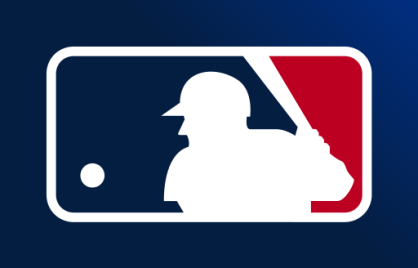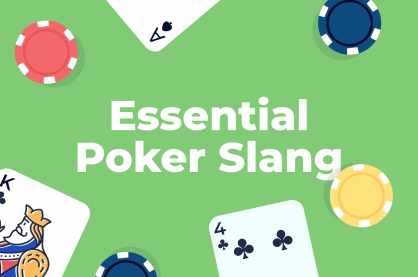Heads Up Poker: Mastering the Head to Head
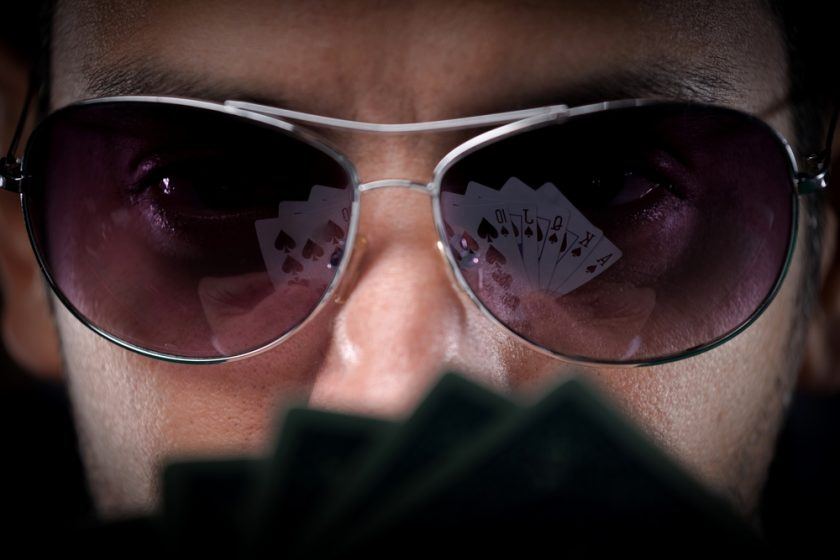
Heads Up Poker: What You Need to Know
- Heads Up poker is a thrilling form casino game played between just two players, requiring a unique strategy and understanding of your opponent’s tendencies.
- Position is paramount in Heads Up poker. The player on the button acts first pre-flop but last post-flop, creating strategic implications.
- The range of poker hands you play should be wider in Heads Up poker. Even hands considered weak in full-ring games can be strong heads up.
- Observing and adapting to your opponent’s patterns online or at the casino and playing style is essential to success in a one-on-one match.
- In Heads Up poker, aggression often pays off. Players need to be prepared to bet and raise frequently to exert pressure on their opponents.
Are you looking to play – and master – heads up poker? You’re in the right place. Brace yourself for one of the purest, most iconic, and volatile forms of No Limit Texas Hold ‘Em.
What is Heads Up Poker?
Heads-up poker is a form of poker that is played between only two players. It can occur in tournaments, including in the latter stages when all other players have been eliminated, or can be arranged as a single match up.
This format requires a different strategic approach compared to traditional poker games involving more players. Each player’s position changes every hand, with the dealer button and small blind being held by the same player, and the other player holding the big blind.
Why Do They Say Heads Up in Poker?
“Heads Up” in poker refers to a game that is played between just two players. The term “heads up” has been used in many competitive activities to describe a one-on-one situation.
It’s believed to have originated from the visual notion of two people putting their “heads up” against each other in a direct competition or duel.
In poker, when all other players have folded or been eliminated, the final two are said to be playing “heads up”.
How to Play Heads Up Poker: The Basics
To get started with the poker table positions:
- Place a ‘button’ marker in front of one player. This can be any object — an empty deck of cards box, a cup, an eraser, a lucky rabbit’s foot. As long as it’s easily visible to both players, you can use it as your button.
- The button player will act as the ‘small blind’. Player two will act as the ‘big blind.’
- If the game is $1/$2 for example, the player on the button would pay $1 and their opponent would pay $2 before any of the cards are dealt.
- The button player acts first preflop, and the big blind acts last post flop.
- Rotate the button each hand.
Poker Heads Up: Who is The Big Blind?
In heads-up play, the dealer button still rotates between the two players, but the person who has the button is the small blind and acts first pre-flop. After the flop, the player on the button acts last. The other player, who is not on the button, is the big blind.
What is The Difference Between Heads Up Poker And Ring Games
The main differences between heads up and ring games are as follows. Typical ‘ring games’ will have a full table of players. (Online poker tables are usually six-handed and live casinos generally seat 8 or 9 players per table.)
Because you are not waiting for an entire table of people to make their decisions, heads up poker is much faster. You will see many more hands when you play heads up than when you are in a full ring game. Strategically, ring games require patience. Heads up requires aggression.
Breaking Down the Poker Jargon
‘The button player acts first preflop, and big blind acts last postflop’ — huh? What does this mean?
I’ll simplify the poker jargon for you. Here’s an example.
- You and your friend are playing $0.25/$0.50 heads up poker.
- You are on the button which is always simultaneously the small blind and pay $0.25.
- Your friend in the big blind pays $0.50.
- You are each dealt your two private hole cards face-down. In this scenario, you are dealt a fantastic pair of aces!
- You raise to $1.50.
- Your friend calls the $1.50. Since they already have $0.50 invested, they only need to contribute $1.00 more.
- The flop — three public, face-up community cards — is dealt. In this case, the flop reveals: 2♦6♠A♥
- Wow! You’ve hit three-of-a-kind! But it’s your friend’s turn first. You must wait for them to make a decision. Your friend opts to check (no bet).
- Now it’s your turn. You bet $2.00.
- Your friend folds.
Do you see how you made the first decision before the cards were dealt? But after the cards were dealt, it was your friend’s turn first? This is the sequence of heads up poker… and then you rotate positions after the completion of the hand.
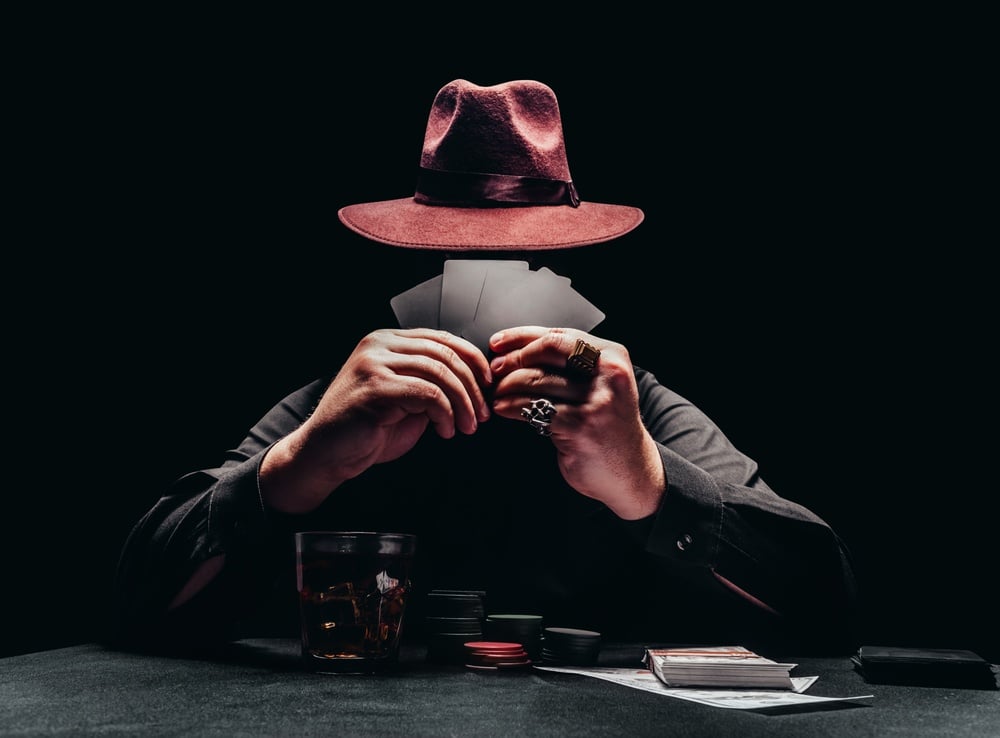
Image Credit: Kitreel/Shutterstock
Practicing Your Heads up Texas Hold’em Skills
What if you’re thinking, ‘Help! I’m still lost!’ or ‘I don’t have any friends!’ Don’t fear — technology is here.
Free video poker is a great way to practice and learn how to play heads up poker without worrying about all the set-up, sequencing, and positioning. The apps will take care of that for you.
I highly recommend beginners start digitally when possible. A computer will deal cards at least 3x faster than a human, so you will master the gameplay mechanics at a much higher speed.
You also don’t need to waste brain space on small blind/big blind logistics. These come much more intuitively when cards are automatically dealt to you and this prevent confusing mistakes.
Even if you have a friend who is excited for two player poker, you may still want to start by playing versus each other on video poker. Shuffling cards and counting bets manually gets old quickly.
Why is Heads Up Poker Strategy More Aggressive?
Good question — let’s explain this conceptually. When you are seated at a table with eight other players, there is a good chance someone has been dealt a very good hand. Perhaps even two people have. Or three. There is a high likelihood that your hand will be beat. Again, you need to best all the other players.
Compare this to when you play heads up, where you are only faced with one opponent. Is it more or less likely your hand will win?
Much more likely. Why? The reason is that you only need to beat one player as opposed to eight players.
How Does This Impact Your Poker Strategy?
Since it’s less likely to have been dealt the worst hand before the flop, you can adjust by playing a wider variety of cards. As it’s less likely for either of you to have made a very strong hand after the flop, you can call bluffs more often and bluff more yourself.
As a theoretical example, you should generally not try to bluff five people. Someone is bound to have a very strong holding.
But bluffing one person? That is a much easier task. In heads up, you only need to convince one person to fold as opposed to an entire table.
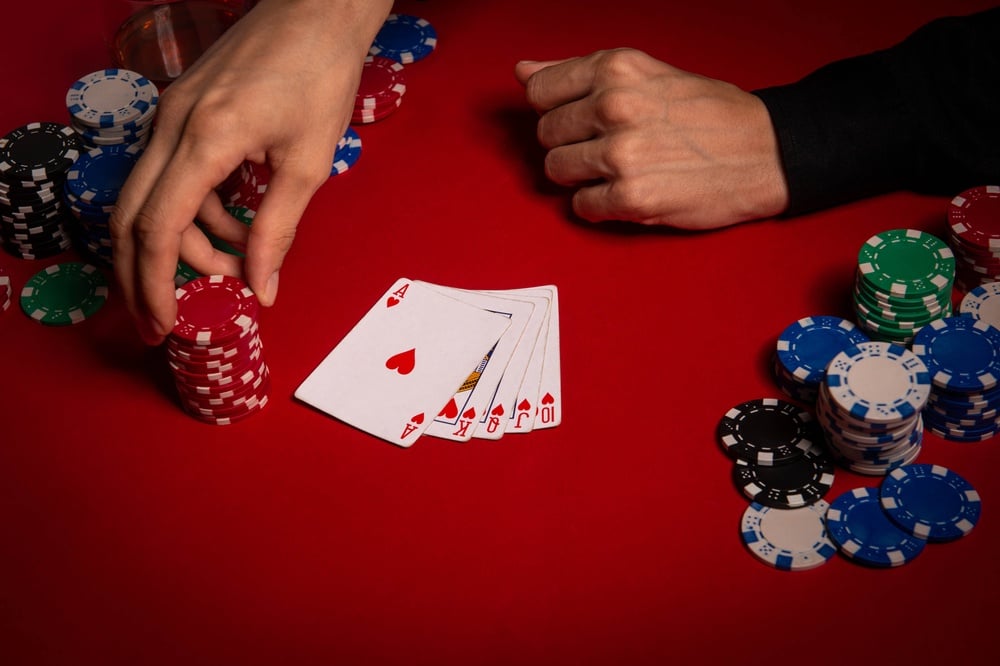
Image Credit: Vlasov Yevhenii/Shutterstock
What is a ‘Good Hand’ in Heads up Hold’Em?
Even though the heads up poker rules are still the same, what qualifies as a ‘good poker hand’ differs wildly.
Building upon the section above, if you want to defeat, let’s say, three opponents, you need to feel pretty confident in your holding. You need to have really strong cards that can best multiple people.
When playing heads up, however, a measly pair is often a pretty good hand. You only need to best one other person, and their cards might not have hit anything. This means the definition of a strong hand changes.
Something as simple as a pair is often good enough to beat one random hand, but rarely good enough to beat several.
A Casino Game is Not Your Home Game
A cautionary tale — before you learn how to play poker in heads up format. Many people start learning how to play poker by practicing in a two player format with their family or friends — then they go to a casino and get torn apart. They are dumbfounded as to how they keep losing.
This is because what constitutes a good hand has changed. Yes, a high pair or three-of-a-kind will probably win against your dad or sibling when playing one-on-one. But don’t be surprised when you go to a casino betting on your pair of kings — only to find your opponents flipping over straights and flushes.
Beware of learning how to play head up poker as your starting point because the threshold for a good hand is much lower. What is good enough to win against two or three players will likely not cut it versus a big group. Keep this in mind when you transition from playing heads up at your kitchen table to live at the casino.
Why Should You Learn to Play Heads Up Poker?
I hope I’ve sufficiently scared you in the previous section. Too many people lose their money and have a terrible first time transitioning to a casino because their idea of relative hand strength is skewed. They ‘overvalue’ their hands.
For this reason, I actually recommend beginners do not start by playing heads up. You can use those same apps, computer programs, and online casinos to practice playing full ring poker at home. Should you even learn to play heads up poker at all? Honestly, it depends.
If your ambition is to play recreational home games or cash games at a casino, learning how to play heads up poker may do you more harm than good.
Heads up poker reinforces bad habits and false feedback that too many hands are valuable when they’re not. Playing heads up poker may lure you into a false sense of security where you overvalue your relative hand strength.
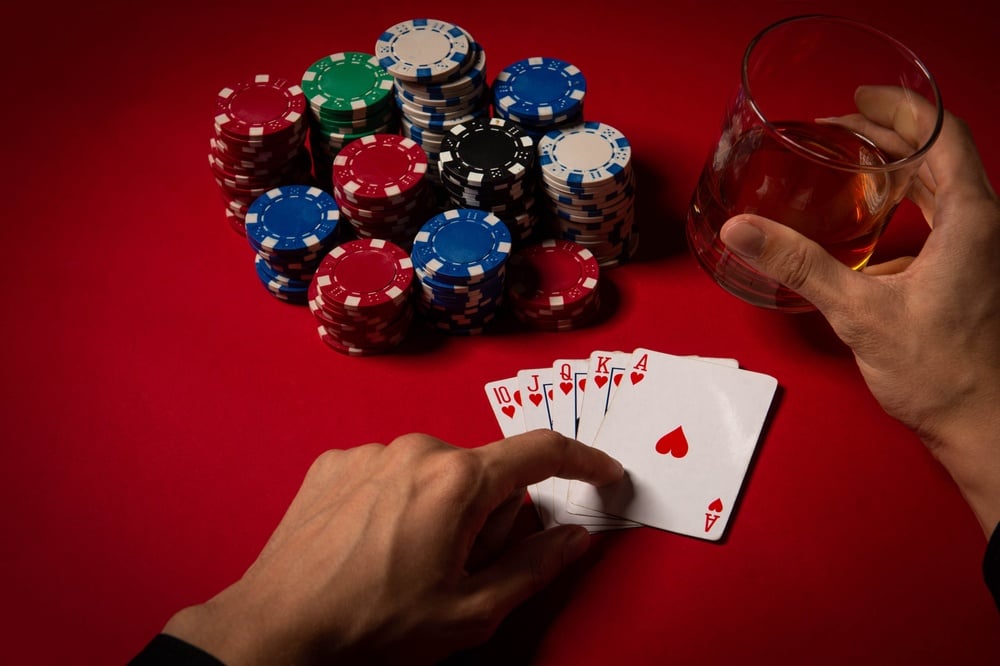
Image Credit: Vlasov Yevhenii/Shutterstock
The Benefits of Learning Heads Up Poker
There are just three major reasons why I would recommend playing heads up:
- People skills: Since you are only battling against one other person, you are more able to capture a ‘tell’ or get a read. (This includes playing online by the way — even when you cannot visually see your opponent, timing tells do exist.) Heads up poker can sharpen your ability to read another and maintain your own poker face.
- Creativity and bluff frequency: If you’re nervous about playing poker and the idea of bluffing makes your stomach drop, then heads up is a great way to practice. The lower likelihood of your opponent having a strong hand encourages you to play more creatively and make bold moves. Bluffing heads-up is less risky than in a full-ring game due to fewer players potentially holding strong hands.
- Tournaments: If you intend to play poker tournaments, you need to know how to play heads up. Tournaments play down to a winner —- when the field narrows to the final few players, you want to be comfortable playing in the bluffier, looser style in order to close the deal.
Taking Advantage of Heads Up Insecurities
Many local casinos have daily tournaments which will usually not play down to a winner. Instead, the players will propose a ‘chop’ — dividing the winnings proportionately by chip stack. For example, the person with the biggest stack will earn close to the first place payout.
Most players will favor a chop deal because they are afraid to play heads up. You can exploit this. They will likely not have experience or confidence in playing heads up poker. Just knowing the two basic strategic principles will give you a huge advantage:
- Play more hands: You are much more likely to have a good hand when faced with fewer opponents.
- Bluff more frequently: Your opponent is much less likely to have a hand good enough to call you with.
Lowering your threshold of what constitutes a good hand underlines all heads up strategy.
Also keep in mind that when someone proposes a chop, it’s not decided by a majority vote. Everyone at the final table could vote in favor of a chop except one person —- and the deal is off. It only takes one objection. Since so many people are insecure about playing heads up, you can use this to your advantage.
Win Without Actually Playing
I once found myself at the final table of a daily poker tournament at a local casino. With six players remaining, I was fourth in chips. The others suggested an ‘ICM’ chop, offering me a payout close to fourth place. I countered that I was happy to agree to a chop… if I was offered second-place prize money.
They laughed, then they screamed. They were furious — how could I propose such a thing? How could I be so audacious? Well, I knew that their eagerness to make a deal and resistance to playing heads up was something I could use to my advantage. A few minutes later, they reluctantly agreed.
Their fear of playing heads up and my confidence in the format allowed me to successfully drive a hard bargain, and secure a juicy second place prize.
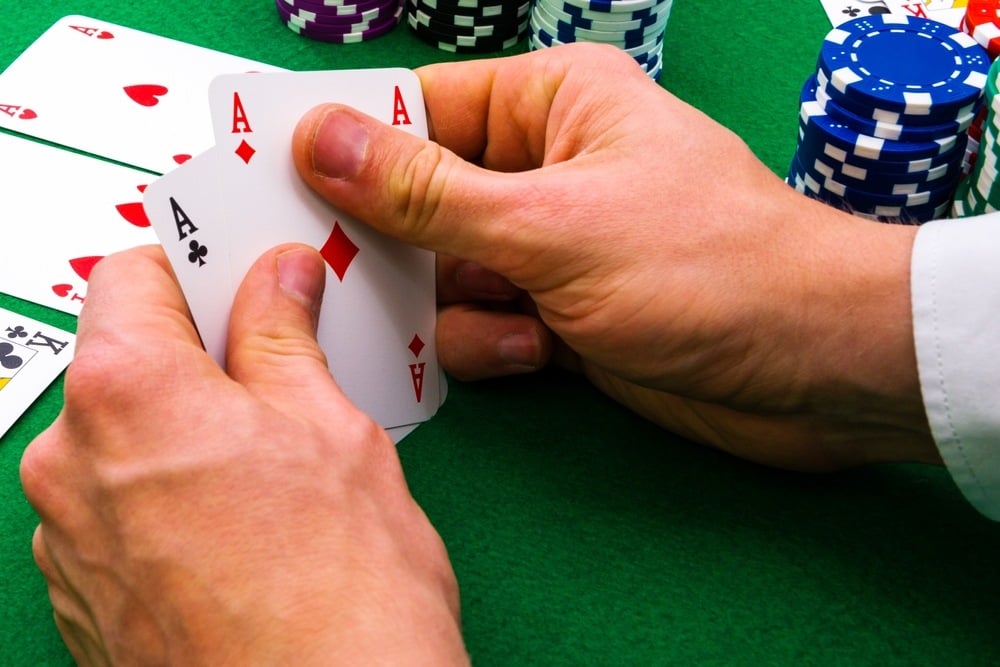
Image Credit: Blezzer/Shutterstock
Final Strategy Shift: The Math Changes
We now know that everything in heads up poker strategy is driven by the fact that it’s less likely you’re up against a strong hand. This means you should play more hands and bluff more frequently. Since your opponent will likely employ the same heads up poker strategy changes, you might want to call down their bets lighter.
You also need to be aware that the math shifts too.
When you play heads up, you want to avoid chasing too many draws like flushes or straights. The reason why is that your ‘pot odds’ are almost always going to be worse.
An Example of The Math Changing
Let’s say someone bets $10 and four people call. There is now $50 in the middle just from the flop round alone, and you are faced with a decision with a flush draw. Should you call the $10? Absolutely — you are calling $10 to win a pot of what will be over $60 (their $50 bets + your $10 + any preflop money). That’s a great price!
A flush draw will complete around 36% of the time — so you’re getting great odds to draw. (Read more on poker probabilities in my cheat sheets here or purchase my book A Girl’s Guide to Poker.)
Since more people participated in the hand, there’s more money in the middle. You are thereby more incentivized to ‘chase’ your big draw. Because if you win, you will 6x your money! That should entice you to take the 36% gamble!
But now let’s say you’re playing heads up, and your opponent has bet $10. You now have to call $10 to win a pot that so far totals maybe a little over $20 (their $10 + your $10 + preflop bets). A 2x return on your money isn’t as appealing as a 6x return now, is it? In this case, the 36% gamble doesn’t look as fun at all.
Instead focus on ‘made hands’ that are already completed rather than draws. Because, hey, as you now know, when you play heads up poker, even a pair can be pretty good.

